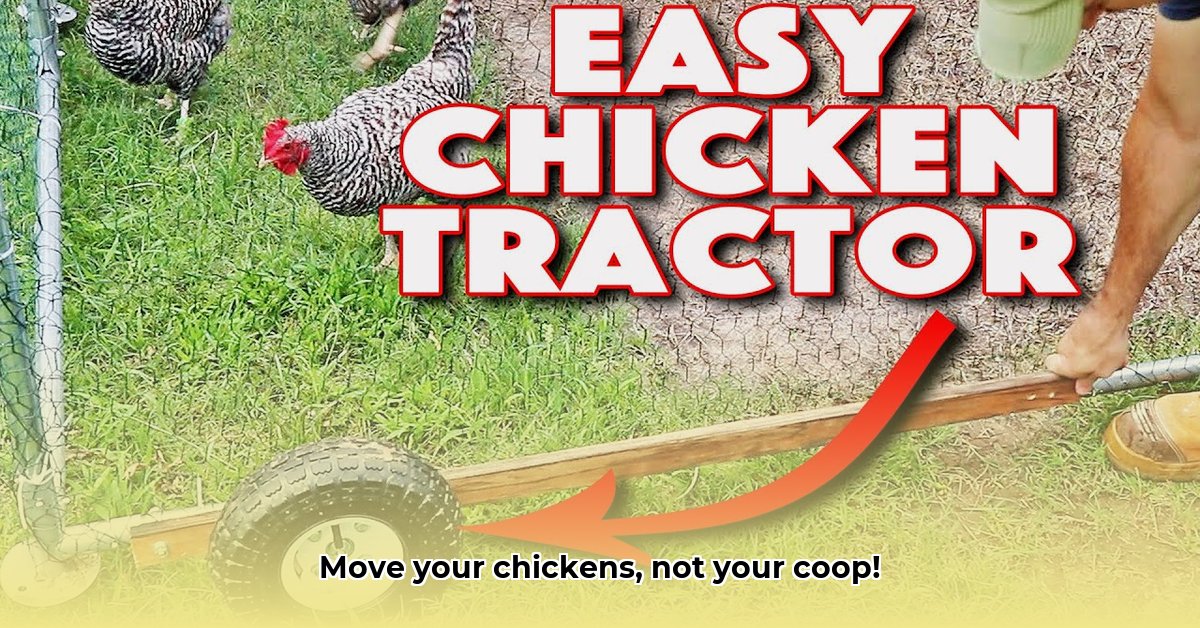
Want fresh, farm-fresh eggs and healthier soil? Building your own mobile chicken coop, or chicken tractor, is a rewarding project that improves your garden and provides delicious eggs. This comprehensive guide walks you through every step, from planning and design to construction and long-term management. For even more detailed instructions, check out this helpful chicken tractor guide. Let's get started!
Designing Your Mobile Chicken Haven
Before you start building, consider the size, materials, and design of your chicken tractor. The size depends on your flock – a small flock of 2-4 hens needs less space than a larger group. How much grazing area will your hens have access to?
Choosing Your Materials
Several materials work well for building a chicken tractor. Each has pros and cons:
- Pressure-Treated Wood: Durable and rot-resistant, it's readily available. However, some worry about the chemical treatments.
- Reclaimed Wood: An eco-friendly and budget-friendly alternative, it adds character. Check for nails or rot before using.
- Cedar: Naturally rot-resistant and aromatic, but more expensive.
For the sides, you'll need sturdy hardware cloth (a strong wire mesh) to keep your chickens safe and predators out (raccoons, foxes, etc.). Finally, select durable wheels appropriate for your terrain. Larger, more rugged wheels work better on uneven ground.
Design Variations: Simple to Spectacular
Here are two design options:
- The "Basic Brooder": A simple rectangular design, perfect for beginners with small flocks. It's easy to build and provides basic shelter.
- The "Deluxe Hen Palace": This more complex design includes a nesting box, separate food and water areas, and potentially a covered area for shade. Ideal for larger flocks and those seeking a luxurious chicken experience.
(Include diagrams or 3D models here)
Building Your Chicken Tractor: A Step-by-Step Guide
Remember safety first! Always wear safety glasses and work gloves.
Step 1: Cut the Lumber: Accurately measure and cut all your lumber according to your plans. Precision here makes the rest of the process easier.
Step 2: Build the Frame: Assemble the main frame using screws or nails. Corner braces add extra strength and stability. Regularly check that your structure is square.
Step 3: Add the Hardware Cloth: Attach the hardware cloth to the sides and back, overlapping edges to create a secure barrier against predators. Ensure no gaps exist.
Step 4: Install Wheels and Axles: Securely attach the wheels and axles, ensuring they can support the weight. A simple locking mechanism prevents unwanted movement.
Step 5: Install Doors and Hinges: Sturdy hinges provide easy access for feeding and cleaning.
Step 6: Add Roosting Bars and Nesting Box (optional): Position roosting bars and nesting boxes for your hens' comfort and privacy.
Mobility and Setup: Moving Your Mobile Coop
The portability of a chicken tractor is a huge advantage. Simply pull it to a new, level location and secure it with stakes or weights to prevent rolling. Moving it daily or every other day provides access to fresh pasture.
Maintenance and Troubleshooting
Regular cleaning is crucial. Remove droppings daily to prevent ammonia buildup and disease. Regularly inspect the structure for damage and repair or replace worn parts. Consider supplemental predator control measures (like electric netting) if necessary. Have you considered the impact of predator damage on your ROI? Minimizing losses is key to maximizing profits.
Material Selection: A Detailed Comparison
| Material | Pros | Cons | Sourcing Tips |
|---|---|---|---|
| Pressure-Treated Wood | Durable, rot-resistant, readily available | Chemical treatment may be a concern for some | Home improvement stores, lumber yards |
| Reclaimed Wood | Eco-friendly, cost-effective, unique character | May require more preparation, potential for rot | Local salvage yards, Craigslist, Habitat for Humanity ReStores |
| Cedar | Naturally rot-resistant, aromatic, beautiful | More expensive than other options | Lumber yards, home improvement stores |
Long-Term Management: Rotational Grazing
Moving your chicken tractor regularly promotes rotational grazing, enriching your soil. This prevents soil depletion, reduces parasites, and creates a naturally fertilized area. You may need to supplement your hens' diet with commercial feed depending on pasture quality. Regularly monitoring your flock's health is crucial for success.
Calculating Your Return on Investment (ROI)
A well-planned chicken tractor offers excellent ROI. Here’s how to calculate yours:
- Initial Investment: Total cost of materials, tools, and labor.
- Annual Operating Costs: Yearly expenses: feed, bedding, veterinary care, maintenance.
- Annual Revenue: Estimated annual egg production and market value, plus potential manure income.
- Net Annual Profit: Annual revenue minus annual costs.
- ROI Calculation: (Net Annual Profit / Initial Investment) x 100%
Remember, this is a simplified calculation. More detailed methods should factor in depreciation, inflation, and other variables. Using a spreadsheet is recommended. Dr. Emily Carter, Professor of Agricultural Economics at the University of California, Berkeley, emphasizes the importance of accurate record-keeping in assessing the true financial impact of such agricultural ventures.
Beyond the Basics: Continuous Learning
Building a chicken tractor is a starting point. Observe your chickens and make adjustments as needed. Experiment with designs, materials, and management to optimize your setup.